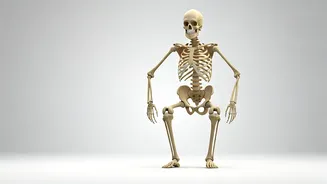Proper Walking Shoes
The cornerstone of a good walking routine starts with the right footwear. Doctors emphasize the importance of choosing walking shoes designed specifically
for the activity. These shoes should offer adequate cushioning to absorb the impact of each step and protect your joints. Furthermore, they need to provide good arch support to maintain proper foot alignment, which prevents strain and discomfort. Consider the fit: shoes should be snug but not tight, with enough room in the toe box to allow your toes to move freely. Look for shoes made of breathable materials to reduce the risk of blisters and promote comfort, especially during longer walks or in warmer weather. Regularly inspect your shoes for wear and tear, replacing them when the cushioning wears out to maintain optimal support and protection.
Supportive Socks Matter
Beyond shoes, the right socks can significantly enhance your walking experience. Opt for socks made of moisture-wicking materials like merino wool or synthetic blends. These materials help keep your feet dry by drawing sweat away from your skin, reducing the risk of blisters and fungal infections. Avoid cotton socks, as they tend to absorb moisture and can make your feet feel clammy and uncomfortable. Look for socks with extra padding in the heel and ball of the foot for added cushioning and shock absorption. The right socks provide an additional layer of comfort and protection, allowing you to walk longer and more comfortably. Furthermore, consider compression socks, which can improve circulation and reduce fatigue, especially during longer walks.
Stay Hydrated Always
Staying hydrated is crucial for any physical activity, and walking is no exception. Doctors advise carrying a water bottle to replenish fluids lost through sweat. Aim to drink water consistently throughout your walk, rather than waiting until you feel thirsty. Dehydration can lead to fatigue, muscle cramps, and headaches, which can significantly detract from your walking experience. Consider adding electrolytes to your water, particularly if you are walking in hot weather or for extended periods. Electrolytes, like sodium and potassium, help replace minerals lost through sweat, maintaining the body's fluid balance and preventing muscle cramps. Having a plan for hydration will not only keep you energized but also support overall health.
Sun Protection is Key
Protecting yourself from the sun's harmful rays is essential when walking outdoors. Doctors recommend wearing sunscreen with a high SPF (Sun Protection Factor) to shield your skin from sunburn and long-term damage. Apply sunscreen liberally to all exposed skin, including your face, neck, arms, and legs. Reapply it every two hours, or more frequently if you are sweating or swimming. Besides sunscreen, consider wearing a hat with a brim to shade your face and neck, and sunglasses to protect your eyes from the sun's glare. Wearing light-colored, loose-fitting clothing can also help reflect the sun's rays and keep you cool. Incorporating these measures will make your walks safer and more enjoyable.
Comfortable, Appropriate Clothing
Choosing the right clothing can greatly impact the comfort and effectiveness of your walks. Doctors suggest dressing in layers, as this allows you to adjust your clothing to changing weather conditions. Wear moisture-wicking fabrics that pull sweat away from your skin, keeping you dry and comfortable. Avoid wearing heavy, restrictive clothing that can hinder your movement and cause overheating. In cooler weather, consider a lightweight jacket or vest to provide extra warmth. Reflective gear is crucial if you walk in low-light conditions, ensuring you are visible to others. Furthermore, choose clothing that allows for a full range of motion. The right choice in clothing maximizes comfort and ensures safety.
A Sturdy Walking Stick
A walking stick or trekking poles can offer numerous benefits, especially for those who need extra support or walk on uneven terrain. Doctors suggest using a walking stick to improve balance and reduce stress on your joints. It is particularly helpful for people with knee or hip problems or those recovering from injuries. The use of walking sticks engages the upper body, increasing calorie burn and enhancing overall fitness. The right stick aids in maintaining an upright posture, which helps in proper breathing and reduces strain on your back. Select a stick with an adjustable height to match your height and walking style, ensuring a comfortable and effective experience. A walking stick becomes an investment in both your safety and fitness.
A Route Planning Device
Planning your walking route in advance can significantly enhance your safety and enjoyment. Doctors recommend using a map, GPS device, or smartphone app to plan your walks. These tools allow you to explore new routes, track your progress, and avoid getting lost. Ensure the route you choose aligns with your fitness level and walking goals, choosing routes that are safe, well-lit, and free of hazards. Always let someone know your walking route and expected return time, especially if you are walking alone. Take a fully charged phone with you, in case you need to contact someone in an emergency. Preparing the route, therefore, supports peace of mind and allows for more focused exercise.
Prioritize Safety First
Safety is paramount when walking, as advocated by doctors. Always be aware of your surroundings, avoiding distractions like phone calls or texting. Stick to well-lit areas, particularly if you are walking during the early morning or evening hours. Wear reflective gear if walking in low-light conditions. Be mindful of traffic and cross streets at designated crosswalks, always looking both ways before crossing. Carry identification and emergency contact information with you. If you encounter any hazards, like aggressive animals or unsafe conditions, do not hesitate to turn back or find an alternative route. Prioritizing safety will make sure your walk remains a beneficial activity.












